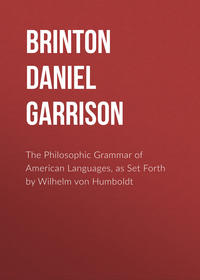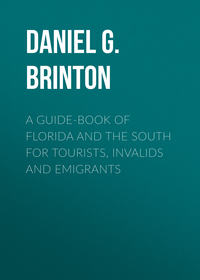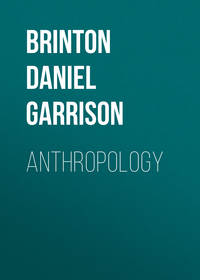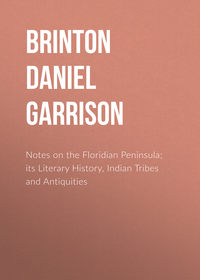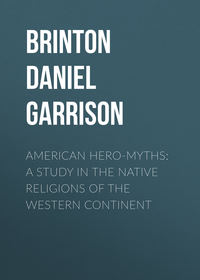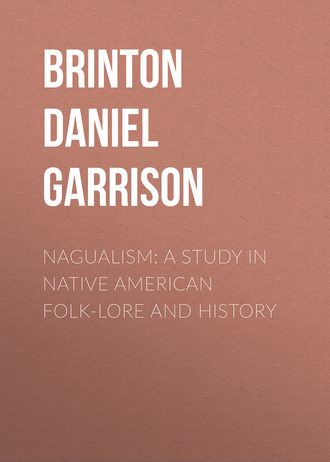 полная версия
полная версияNagualism: A Study in Native American Folk-lore and History
2
For instance, in “The Names of the Gods in the Kiche Myths,” pp. 21, 22, in Proceedings of the American Philosophical Society, 1881; Annals of the Cakchiquels, Introduction, p. 46; Essays of an Americanist, p. 170, etc.
3
Historia de las Indias Occidentales, Dec. iv, Lib. viii, cap. 4.
4
More especially it is the territory of the Chorti dialect, spoken to this day in the vicinity of the famous ancient city of Copan, Honduras. Cerquin lies in the mountains nearly due east of this celebrated site. On the Chorti, see Stoll, Zur Ethnographie der Republik Guatemala, pp. 106-9.
5
Bernardino de Sahagun, Historia de la Nueva España, Lib. x, cap. 9.
6
Derived from teciuhtlaza, to conjure against hail, itself from teciuh, hail. Alonso de Molina, Vocabulario Mexicano, sub voce.
7
Bautista, Advertencias para los Confesores, fol. 112 (Mexico, 1600).
8
Nicolas de Leon, Camino del Cielo, fol. 111 (Mexico, 1611).
9
Paso y Troncoso, in Anales del Museo Nacionàl de Mexico, Tom. iii, p. 180.
10
Sahagun, Historia de Nueva España, Lib. x, cap. 29, and Lib. xi, cap. 7. Hernandez has the following on the mysterious properties of this plant: “Illud ferunt de hac radice mirabile (si modo fides sit vulgatissimæ inter eos rei habendæ), devorantes illam quodlibet prsæsagire prædicereque; velut an sequenti die hostes sint impetum in eos facturi? Anne illos felicia maneant tempora? Quis supellectilem, aut aliud quidpiam furto subripruerit? Et ad hunc modum alia, quibus Chichimecæ hujusmodi medicamine cognoscendis.” Franciscus Hernandus, Historia Plantarum Novæ Hispaniæ, Tom. iii, p. 71 (Ed., Madrid, 1790).
11
Diccionario Universal, Appendice, Tom. i, p. 360 (Mexico, 1856).
12
Confessionario Mayor y Menor en lengua Mexicana, fol. 8, verso (Mexico, 1634).
13
Vetancurt, Teatro Mexicano, Trat. iii, cap. 9.
14
Hernandez, Historia Plantarum Novæ Hispaniæ, Tom. iii, p. 32.
15
Dr. Jacinto de la Serna, Manual de Min stros de Indios para el Conocimiento de sus Idolatrias y Extirpacion de Ellas, p. 163. This interesting work was composed about the middle of the seventeenth century by a Rector of the University of Mexico, but was first printed at Madrid, in 1892, from the MS. furnished by Dr. N. Leon, under the editorship of the Marquis de la Fuensanta del Valle.
16
MSS. of the Licentiate Zetina, and Informe of Father Baeza in Registro Yucateco, Tom. i.
17
Acosta, De la Historia Moral de Indias, Lib. v, cap. 26.
18
Of the thiuimeezque Hernandez writes: “Aiunt radicis cortice unius unciæ pondere tuso, atque devorato, multa ante oculos observare phantasmata, multiplices imagines ac monstrificas rerum figuras, detegique furem, si quidpiam rei familiaris subreptum sit.” Hist. Plant. Nov. Hispan., Tom. iii, p. 272. The chacuaco and its effects are described by Father Venegas in his History of California, etc.
19
“In Mictlan Tetlachihuique, in Nanahualtin, in Tlahuipuchtin.” Paredes, Promptuario Manual Mexicano, p. 128 (Mexico, 1757). The tlahuipuchtin, “those who work with smoke,” were probably diviners who foretold the future from the forms taken by smoke in rising in the air. This class of augurs were also found in Peru, where they were called Uirapircos (Balboa, Hist. du Perou, p. 28-30).
20
Von Gagern, Charakteristik der Indianischer Bevölkerung Mexikos, s. 125.
21
Historia Antigua de Mexico, Tom. ii, p. 25. Francisco Pimentel, in his thoughtful work, Memoria sobre las Causas que han originado la Situacion Actual de la Raza Indigena de Mexico (Mexico, 1864), recognizes how almost impossible it is to extirpate their faith in this nagualism. “Conservan los agueros y supersticiones de la antigüedad, siendo cosa de fe para ellos, los nahuales,” etc., p. 200, and comp. p. 145.
22
On these terms consult the extensive Dictionnaire de la Langue Nahuatl, by Rémi Simeon, published at Paris, 1887. It is not impossible that tona is itself a compound root, including the monosyllabic radical na, which is at the basis of nagual.
23
Sahagun, Historia de Nueva España, Lib. iv, passim, and Lib. x, cap. 9.
24
See Ch. de Labarthe, Révue Américaine, Serie ii, Tom. ii, pp. 222-225. His translation of naualteteuctin by “Seigneurs du gènie” must be rejected, as there is absolutely no authority for assigning this meaning to naualli.
25
Anales de Cuauhtitlan, p. 31. The translator renders it “palo brujo.”
26
Les Anciennes Villes du Nouveau Monde, pp. 146-148, figured on p. 150. On its significance compare Hamy, Decades Americanæ, pp. 74-81.
27
The Native Calendar of Central America and Mexico (Philadelphia, 1893).
28
Eduard Mühlenpfordt, Mexico, Bd. i, s. 255.
29
The word is derived from tlatoa, to speak for another, and its usual translation was “chief,” as the head man spoke for, and in the name of the gens or tribe.
30
The interesting account by Iglesias is printed in the Appendix to the Diccionario Universal de Geographia y Historia (Mexico, 1856). Other writers testify to the tenacity with which the Mixes cling to their ancient beliefs. Señor Moro says they continue to be “notorious idolaters,” and their actual religion to be “an absurd jumble of their old superstitions with Christian doctrines” (in Orozco y Berra, Geografia de las Lenguas de exico, p. 176).
31
For instance, J. B. Carriedo, in his Estudios Historicos del Estado Oaxaqueño (Oaxaca, 1849), p. 15, says the nahualt was a ceremony performed by the native priest, in which the infant was bled from a vein behind the ear, assigned a name, that of a certain day, and a guardian angel or tona. These words are pure Nahuatl, and Carriedo, who does not give his authority, probably had none which referred these rites to the Zapotecs.
32
Juan de Cordova, Arte en Lengua Zapoteca, pp. 16, 202, 203, 213, 216.
33
Quoted in Carriedo, ubi suprá, p. 17.
34
Hist. de las Indias Oc., Dec. iii, Lib. iii, cap. 12.
35
So I understand the phrase, “figuras pintadas con zifras enigmaticas”
36
Popoluca was a term applied to various languages. I suspect the one here referred to was the Mixe. See an article by me, entitled “Chontales and Popolucas; a Study in Mexican Ethnography,” in the Compte Rendu of the Eighth Session of the Congress of Americanists, p. 566, seq.
37
Constit. Diocesan, p. 19.
38
Constitut. Diocesan, Titulo vii, pp. 47, 48.
39
Rather with the Quetzalcoatl of the Nahuas, and the Gucumatz of the Quiches, both of which names mean “Feathered Serpent.” Mixcohuatl, the Cloud Serpent, in Mexican mythology, referred to the Thunder-storm.
40
In his Tzental Vocabulary, Father Lara does not give this exact form; but in the neighboring dialect of the Cakchiquel Father Ximenes has quikeho, to agree together, to enter into an arrangement; the prefix zme is the Tzental word for “mother.”
41
Father Lara, in his Vocabulario Tzendal MS. (in my possession), gives for medical (medico), ghpoxil, for medicine (medicinal cosa), pox, xpoxtacoghbil; for physician (medico), ghpoxta vinic (the form vanegh, person, is also correct). The Tzendal pox (pronounced pōsh) is another form of the Quiche-Cakchiquel pūz, a word which Father Ximenes, in his Vocabulario Cakchiquel MS (in my possession), gives in the compound puz naual, with the meaning, enchanter, wizard. Both these, I take it, are derived from the Maya puz, which means to blow the dust, etc., off of something (soplar el polvo de la ropa ó otra cosa. Dicc. de la Lengua Maya del Convento de Motul, MS. The dictionary edited by Pio Perez does not give this meaning). The act of blowing was the essential feature in the treatment of these medicine men. It symbolized the transfer and exercise of spiritual power. When Votan built his underground shrine he did it à soplos, by blowing (Nuñez de la Vega, Constitut. Diocesan, p. 10). The natives did not regard the comet’s tail as behind it but in front of it, blown from its mouth. The Nahuatl word in the text, tzihuizin, is the Pipil form of xihuitzin, the reverential of xihuitl, which means a leaf, a season, a year, or a comet. Apparently it refers to the Nahuatl divinity Xiuhté cutli, described by Sahagun, Historia de Nueva España, Lib. i, cap. 13, as god of fire, etc.
42
Hicalahau, for ical ahau, Black King, one of the Tzental divinities, who will be referred to on a later page.
43
“Mæstros de los pueblos,” Constitut. Diocesan, i, p. 106.
44
Historia de Guatemala, ò, Recordacion Florida, Tom. ii, p. 44, seq.
45
Gage, A New Survey of the West Indies, p. 388, seq. (4th Ed.).
46
Le Popol Vuh, ou Livre Sacré des Quichés, p. 315 (Ed. Brasseur, Paris, 1861). In the Quiche myths, Gucumatz is the analogue of Quetzalcoatl in Aztec legend. Both names mean the same, “Feathered Serpent.”
47
Baeza’s article is printed in the Registro Yucateco, Vol. i, p. 165, seq.
48
“Wird ein Kind im Dorfe geboren, so erhält der heidnische Götzenpriester von diesem Ereignisse viel eher Kunde, als der katholische Pfarrer. Erst wenn dem neuen Weltbürger durch den Aj-quig das Horoskop gestellt, der Name irgend eines Thieres beigelegt, Mi-si-sal (das citronengelbe Harz des Rhus copallinum) verbrannt, ein Lieblingsgötze angerufen, und noche viele andere aberglaübische Mysterien verrichtet worden sind, wird das Kind nach dem Pfarrhause zur christlichen Taufe getragen. Das Thier, dessen Name dem Kinde kurz nach seiner Geburt vom Sonnenpriester beigelegt wird, gilt gewöhnlich auch als sein Schutzgeist (nagual) fürs ganze Leben.” Dr. Karl Scherzer, Die Indianer von Santa Catalina Istlavacan, p. 11, Wien, 1856.
49
The word zahori, of Arabic origin, is thus explained in the Spanish and English dictionary of Delpino (London, 1763): “So they call in Spain an impostor who pretends to see into the bowels of the earth, through stone walls, or into a man’s body.” Dr. Stoll says the Guatemala Indians speak of their diviners, the Ah Kih, as zahorin. Guatemala, s. 229.
50
Emetorio Pineda, Descripcion Geografica de Chiapas y Soconusco, p. 22 (Mexico, 1845).
51
Madier de Montjau, “Manuscrits Figuratifs de l’ Ancien Mexique,” in Archives de la Sociétè Americaine de France, 1875, p. 245.
52
Torquemada, Monarquia Indiana, Lib. xv, cap. 16.
53
De la Serna, Manual de Ministros, pp. 20, 21, 42, 162. The mushroom referred to was the quauhnanacatl, probably the same as the teyhuinti of Hernandez, Hist. Plant. Nov. Hispan., Tom. ii, p. 358, who says that it is not dangerous to life, but disturbs the mind, inciting to laughter and intoxication.
54
Actual slavery of the Indians in Mexico continued as late as the middle of the seventeenth century. See Cavo, Tres Siglos de Mexico, etc., Tom. ii, p. 11.
55
Brasseur, Hist. des Nations Civilisées de Mexique, Tom. iv, p. 822.
56
Informe del teniente general, Don Jacobo de Barba Figueroa, corregidor de la Provincia de Suchitepeque, quoted by Brasseur.
57
Jacinto de la Serna says: “Los mæstros de estas ceremonias son todos unos, y lo que sucede en esta cordillera en todas sucede.” Manual de Ministros, p. 52. Speaking of the methods of the nagualists of Chiapas, Bishop Nuñez de la Vega writes: “Concuerdan los mas modernos con los mas antiguos que se practicaban en Mexico.” Constituciones Diocesanas, p. 134.
58
He observes that there were “familias de los tales sabios en las quales en manera de patrimonio se heredaban, succediendo los hijos á los padres, y principalmente su abominable secta de Nagualismo.” Historia del Cielo y de la Tierra, MS., p. 7. Ordoñez advances various erudite reasons for believing that Nagualism is a religious belief whose theory and rites were brought from Carthage by Punic navigators in ancient times.
59
Maria de Moxó, Cartas Mejicanas, p. 270, (Genova, n. d.).
60
“Xochimilca, que asi llamavan à los mui sabios encantadores.” Torquemada, Monarquia Indiana, Lib. xv, cap. 16.
61
In Nahuatl, tlapiani, a guardian or watchman. The Zapotec priesthood was divided into the huijatoos, “greater guardians,” and their inferiors, the copavitoos, “guardians of the gods.” Carriedo, Estudios Historicòs, p. 93.
62
See Eligio Ancona. Historia de Yucatan, Tom. iv, cap. 1 (Mérida, 1880).
63
The mention of the fifteen, 5 x 3, chosen disciples indicates that the same system of initiating by triplets prevailed in Yucatan as in Chiapas (see above, p. 19). The sacred tree is not named, but presumably it was the ceiba to which I refer elsewhere. The address of Jacinto was obtained from those present, and is given at length by the Jesuit Martin del Puerto, in his Relacion hecho al Cabildo Eclesiastico por el preposito de la Compañia de Jesus, acerca de la muerte de Jacinto Can-Ek y socios, Dec. 26, 1761. It is published, with other documents relating to this revolt, in the Appendix to the Diccionario Universal, edited by Orozco y Berra, Mexico, 1856. On the prophecies of Chilan Balam, see my Essays of an Americanist, pp. 255-273 (Philadelphia, 1890).
64
Eligio Ancona, Hist. de Yucatan, Tom. ii, p. 452.
65
See Pedro Sanchez de Aguilar, Informe contra Idolum Cultores en Yucathan (Madrid, 1639); Eligio Ancona, Historia de Yucatan, Tom. ii, pp. 128, 129.
66
The chief authority on this revolt is Juan de Torres Castillo, Relacion de lo Sucedido en las Provincias de Nexapa, Iztepex y Villa Alta (Mexico, 1662). See also Cavo, Los Tres Siglos de Mexico durante el Gobierno Español, Tom. ii, p. 41, and a pamphlet by Christoval Manso de Contreras, Relacion cierta y verdadera de lo que sucedio en esta Provincia de Tehuantepec, etc. (printed at Mexico, 1661), which I know only through the notes of Dr. Berendt. Mr. H. H. Bancroft, in his very meagre account of this event, mistakingly insists that it took place in 1660. History of Mexico, Vol. iii, p. 164.
67
See Brasseur de Bourbourg, Histoire des Nations Civilisées de la Mexique, Tom. iv, 824.
68
Cavo, Los Tres Siglos, etc., Tom. ii, p. 82. On the use and significance of the piochtli we have some information in Vetancurt, Teatro Mexicano, Tom. ii, p. 464, and de la Serna, Manual de Ministros, pp. 166, 167. It was the badge of a certain order of the native priesthood.
69
Adventures on the Musquito Shore, by S. A. Ward, pseudonym of Mr. Squier, p. 258 (New York, 1855).
70
Nuñez de la Vega, Constituciones Diocesanas, p. 10, and comp. Brasseur de Bourbourg, Hist. des Nat. Civ. de Mexique, Tom. i, p. 74.
71
Herrera, Hist. de las Indias Occidentales, Dec. ii, Lib. iii, cap. 5.
72
Acosta, Hist. Nat. y Moral de las Indias, Lib. vii, cap. 5.
73
The story is given in Herrera, Hist. de las Indias, Dec. iv, Lib. viii, cap. 4. The name Coamizagual is translated in the account as “Flying Tigress.” I cannot assign it this sense in any dialect.
74
Jacinto de la Serna, Manual de Ministros. p. 138. Sahagun identifies Quilaztli with Tonantzin, the common mother of mankind and goddess of child-birth (Hist. de Nueva España, Lib. i, cap. 6, Lib. vi, cap. 27). Further particulars of her are related by Torquemada, Monarquia Indiana, Lib. ii, cap. 2. The tzitzime were mysterious elemental powers, who, the Nahuas believed, were destined finally to destroy the present world (Sahagun, l. c., Lib. vi, cap. 8). The word means “flying haired” (Serna).
75
Torquemada, Monarquia Indiana, Lib. ii, cap. 62.
76
Fr. Tomas Coto, Diccionario de la Lengua Cakchiquel, MS., s. v. Sacrificar; in the Library of the American Philosophical Society at Philadelphia.
77
“Trataron de valerse del arte de los encantos y naguales” are the words of the author, Fuentes y Guzman, in his Recordacion Florida, Tom. i, p. 50. In the account of Bernal Diaz, it reads as if this witch and her dog had both been sacrificed; but Fuentes is clear in his statement, and had other documents at hand.
78
Teobert Maler, “Mémoire sur l’Etat de Chiapas,” in the Révue d’ Ethnographie, Tom. iii, pp. 309-311. This writer also gives some valuable facts about the Indian insurrection in the Sierra de Alicia, in 1873.
79
The long account given by Mr H. H. Bancroft of this insurrection is a travesty of the situation drawn from bitterly prejudiced Spanish sources, of course, utterly out of sympathy with the motives which prompted the native actors. See his History of the Pacific States, Vol ii, p. 696 sqq. Ordoñez y Aguiar, who lived on the spot within a generation of the occurrences recognizes in Maria Candelaria (whose true name Bancroft does not give) the real head of the rebellion, “quien ordenaba los ardides del motin; … de lo que principalmente trataban las leyes fundamentales de su secta, era de que no quedase rastro alguno de que los Europeos havian pisado este suelo.” His account is in his unpublished work, Historia del Cielo y de la Tierra, written at Guatemala about 1780. Juarros, speaking of their rites, says of them: “Apostando de la fé, profanando los vasos sagrados, y ofreciendo sacrilegos cultos á una indizuela.” Historia de la Ciudad de Guatemala, Tom. i, p. 17.
80
Bancroft, ubi suprà, p. 705, note. One was hanged, whom Garcia Pelaez calls “una india bruja.” Memorias para la Historia de Guatemala, Tom. ii, p. 153.
81
Squier, ubi suprà, passim.
82
Voyage á l’ Isthmus de Tehuantepec, p. 164. He adds a number of particulars of the power she was supposed to exercise.
83
“Que era venerado en todo el imperio de Montezuma.” See Diccionario Universal, Appendice, s. v. (Mexico, 1856).
84
“Dass der Gott Tepeyollotl im Zapotekenlande und weiter südwärts seine Wurzeln hat, und dem eigentlichen Aztekischen Olymp fremd ist, darüber kann kein Zweifel mehr obwalten.” See Dr. Seler’s able discussion of the subject in the Compte-Rendu of the Seventh International Congress of Americanists, p. 559, seq. The adoption of subterranean temples was peculiarly a Zapotecan trait. “Notandose principalmente en muchos adoratorios de los Zapotecos, estan los mas de ellos cubiertos, ò en subterraneos espaciosos y lòbregos.” Carriedo, Estudios Historicos, Tom. i, p. 26.
85
Constituciones Diocesanas, pp. 9, 10.
86
Gage, A New Survey of the West Indies, pp. 389, 393.
87
Teatro Mexicano, Tratado iii, cap. 11. Mr. Bandelier has called attention to the naming of one of the principal chiefs among the Aztecs, Tlilancalqui, “Man of the Dark House,” and thinks it related to the Votan myth. Twelfth Annual Report of the Peabody Museum, p. 689.
88
Herrera, Historia de las Indias Occidentales, Dec. iii, Lib. iii, cap. 14.
89
Villa Señor, Teatro Americano, Lib. v, cap. 38 (Mexico, 1747). Father Cavo adds that there were signs of human sacrifices present, but of this I can find no evidence in the earlier reports. Comp. Cavo, Los Tres Siglos de Mexico durante el Gobierno Españal, Tom. ii, p. 128.
90
Teatro Americano, Lib. ii, cap. 11; Lib. iii, cap. 13.
91
See Mühlenpfordt, Mexico, Bd. ii, pp. 200-266; Brasseur, Hist. des Nations Civ. de la Mexique, Vol. iv, p. 821; Herrera, Historia de las Indias, Dec. iii, Lib. iii, cap. 12, etc.
92
Diccionario Universal, Appendice, s. v.
93
Their names were Ta Yoapa, Father Dawn; Ta Te, Father Stone; Coanamoa, the Serpent which Seizes. Dicc. Univ., App., Tom. iii, p. 11.
94
Duran, Historia de los Indios, Tom. ii, p. 140. They were Tota, Our Father; Yollometli, the Heart of the Maguey (probably pulque); and Topiltzin, Our Noble One (probably Quetzalcoatl, to whom this epithet was often applied).
95
“Fue el Demonio que les dió la superstición del numero nueve.” Manual de Ministros, p. 197.
96
The Native Calendar of Central America and Mexico, p. 12.
97
Motolinia, Ritos Antiguos, Sacrificios e Idolatrias de los Indios de la Nueva España, p. 340 (in Coleccion de Documentos ineditos para la Historia de España).
98
Thomas Coto, Vocabulario de la lengua Cakchiquel, MS., sub voce, Rayo.
99
Herrera, Historia de las Indias, Dec. IV, Lib. viii, cap. 10.





